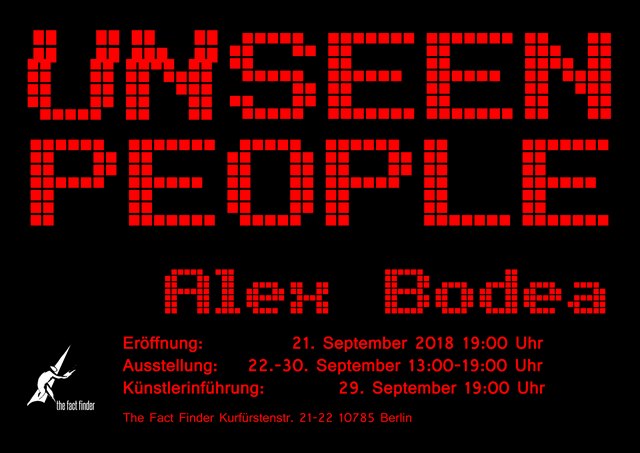(Un)Seen People
Opening: 21. Sept. 2018 19:00
Exhibition: 22.-30. Sept. 13:00-19:00
Artist-guided tour: 29. Sept. 2018 19:00
(Un)Seen People exhibition is based upon the core concept of the Fact Finder, that of the artist being a witness in the world. The artist as a witness when captures the fleeting moments that occur when passing through public spaces in Berlin.
Alex Bodea - Turkish man dressed in full German folk attire - Hamza - Woman under influence
I am a witness when I capture the fleeting moments that occur when passing through public spaces here in Berlin. And I do this on a daily basis, documenting them in the form of visual notes- a drawing with a short text recalling what I have encountered. These visual notes have grown into an archive.
I have chosen three particular moments from the archive involving three passers-by who strike a chord with me. I have chosen them because I feel they embody multi-cultural coexistence, how people borrow habits, clothes, or practices from other cultures and can either form new identities or lose part of their identity in the process. This also generates interesting visual clues, new clues which there is no precedence for and which we have to learn to read.
Sometimes these clues are striking, like in the case of the Turkish man dressed in full German folk attire who I saw on a winter day on Potsdamer Straße, just around the corner from here. The clues are more subtle with ‘Hamza,’ the beautiful immigrant boy whom I caught a glimpse of on the metro. His intricately patterned oriental dress is suppressed by his newly acquired black, mass-produced puffer jacket (Wattejacke), the one that is ubiquitous in Berlin during winter.
And then there is the Eastern European-looking woman, her hair undone, boldly gesticulating against a backdrop of territorial men. Each of them I saw in Berlin on days between April 2017 and April 2018.
To recall these people I use the same simple visual formula. First, there is the full figure drawn on a horizontal plane. Here I extract the essential elements of each character and take out the superfluous ones, just as my emotional memory dictates: the Turkish man’s unusually styled moustache reminiscent of the Ottoman era, or the immigrant boy’s bag made from a recycled Coca-Cola bottle cut in half and inscribed with the word ‘Hamza’- most likely his name.
Then there are the cut-outs in the foreground which re-enact fragmented aspects of the full-figure drawing placed on the wall behind. When you pass by a person in the street, you catch only bits and glimpses over a few seconds: the colour of their hair, the pointy tips of their shoes, the flash of their cell phone exposed in their hand. Throughout the cut-outs, I am recreating the sensation of this fragmented reality. And at times, I allow myself to place the passer-by in imagined situations, like how I imagine Hamza’s circumstances might mean that he works as a Putzhilfe- this being one of the more accessible jobs for migrants in Berlin.
For each of the three passers-by, there is a short text, (street haiku) that summarises my experience of seeing them. I decided to present this on a news ticker because for me it is as important as the news. These are my subjective experiences of real people who I have encountered just for a few seconds, and as they walk away, they are unaware that I have spent, through these works, months in their company.
